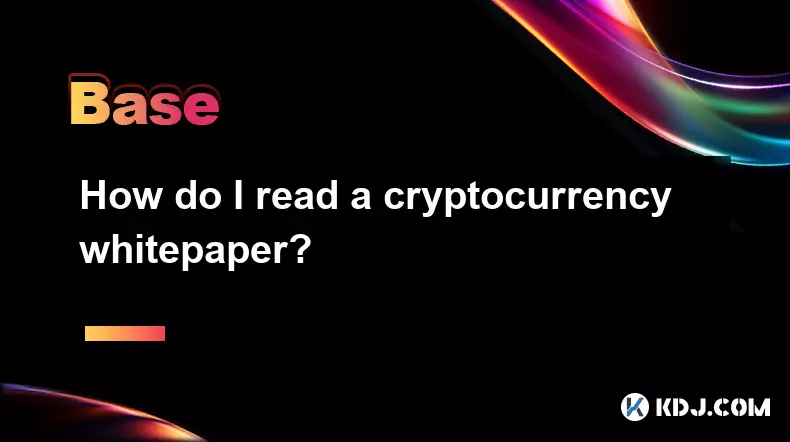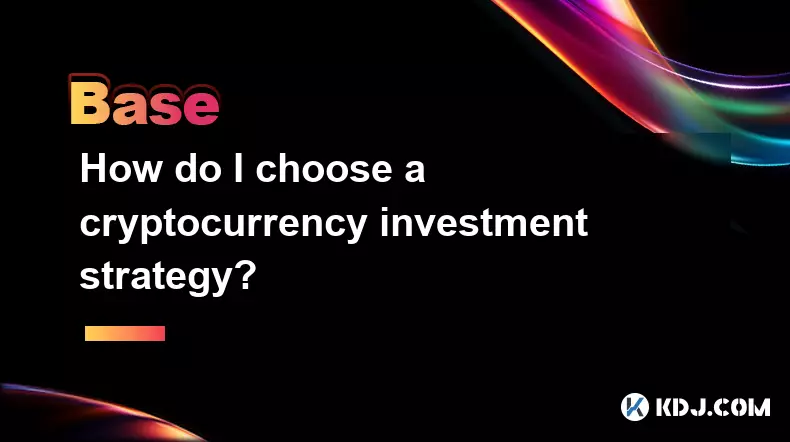-
 bitcoin
bitcoin $114320.977035 USD
-0.40% -
 ethereum
ethereum $4152.439985 USD
-1.75% -
 tether
tether $1.000111 USD
-0.04% -
 xrp
xrp $2.843037 USD
-1.63% -
 bnb
bnb $1013.349380 USD
-1.62% -
 solana
solana $208.362767 USD
-2.10% -
 usd-coin
usd-coin $0.999783 USD
0.00% -
 dogecoin
dogecoin $0.232559 USD
-1.00% -
 tron
tron $0.333491 USD
-1.09% -
 cardano
cardano $0.806310 USD
0.19% -
 hyperliquid
hyperliquid $45.023720 USD
-1.59% -
 ethena-usde
ethena-usde $1.000819 USD
-0.06% -
 chainlink
chainlink $21.241249 USD
-2.11% -
 avalanche
avalanche $30.035416 USD
-0.66% -
 stellar
stellar $0.364984 USD
-2.05%
How to build a crypto portfolio
Building a crypto portfolio involves diversifying digital assets like Bitcoin, Ethereum, and altcoins to manage risk and maximize returns based on your investment goals and risk tolerance.
Jul 14, 2025 at 06:28 am

Understanding the Basics of a Crypto Portfolio
Before diving into the steps to build a crypto portfolio, it's essential to understand what a cryptocurrency portfolio entails. A crypto portfolio is a collection of various digital assets held by an individual or entity. These can include well-known cryptocurrencies like Bitcoin (BTC) and Ethereum (ETH), as well as altcoins, stablecoins, and even non-fungible tokens (NFTs). The goal of building such a portfolio is typically to diversify investments, manage risk, and potentially increase returns.
Each asset in your portfolio plays a different role. For example, Bitcoin is often considered a store of value, while Ethereum provides a platform for decentralized applications. Altcoins may offer specific functionalities or technological advancements. By understanding the purpose and potential of each asset, you can better determine how they fit into your overall investment strategy.
Assessing Your Risk Tolerance and Investment Goals
Building a successful crypto portfolio starts with a clear understanding of your risk tolerance and investment goals. Cryptocurrencies are known for their volatility, so it's crucial to assess how much fluctuation you're comfortable with. Are you looking for short-term gains or long-term growth? Do you have a high-risk appetite or prefer more stable investments?
Once you've established these parameters, you can begin to allocate your capital accordingly. If you're risk-averse, you might lean towards more established cryptocurrencies like Bitcoin and Ethereum, which historically have shown less volatility compared to newer altcoins. Conversely, if you're open to higher risk for potentially greater rewards, you could explore emerging projects and tokens with strong use cases and community support.
Researching Potential Investments
Research is a cornerstone of building a robust crypto portfolio. With thousands of cryptocurrencies available, selecting the right ones requires due diligence. Start by evaluating the technology behind each project. Look into the team's background, the problem the project aims to solve, and its market potential. Whitepapers, official websites, and community forums can provide valuable insights into a project’s legitimacy and prospects.
Additionally, consider the trading volume and market capitalization of the cryptocurrency. High trading volumes can indicate strong interest and liquidity, while a substantial market cap might suggest that the asset has established itself within the market. Tools like CoinMarketCap and CoinGecko can help you compare different cryptocurrencies and track their performance over time.
Diversifying Your Investments
Diversification is a key principle in investing, especially in the volatile world of cryptocurrencies. By spreading your investments across various assets, you can mitigate the impact of any single asset's poor performance on your overall portfolio. Consider allocating your funds across different categories, such as large-cap, mid-cap, and small-cap cryptocurrencies.
For instance, a typical diversified portfolio might include a mix of major cryptocurrencies like Bitcoin and Ethereum, alongside promising altcoins and utility tokens. This approach allows you to benefit from the growth of leading projects while also taking calculated risks on newer ventures. Furthermore, including stablecoins in your portfolio can provide a hedge against market downturns and serve as a source of liquidity when opportunities arise.
Monitoring and Adjusting Your Portfolio
Once your crypto portfolio is built, it's important to regularly monitor its performance and make adjustments as needed. The cryptocurrency market is dynamic, and prices can change rapidly based on news events, regulatory developments, and technological advancements. Set up alerts for significant price movements and stay informed about industry trends to make timely decisions.
Rebalancing your portfolio periodically ensures that your asset allocation remains aligned with your investment goals and risk tolerance. If one cryptocurrency has grown disproportionately compared to others, consider selling some of it to reinvest in undervalued assets. This practice helps maintain a balanced exposure and can enhance your portfolio's resilience during market fluctuations.
Frequently Asked Questions
What percentage of my portfolio should be allocated to cryptocurrencies?
The ideal allocation varies depending on your risk tolerance and investment objectives. Generally, financial advisors suggest that beginners start with a smaller percentage, such as 1-5% of their total portfolio, gradually increasing as they become more comfortable with the market dynamics.
How often should I rebalance my crypto portfolio?
It's advisable to review and rebalance your portfolio quarterly or semi-annually. However, if there are significant market changes or personal circumstances that affect your investment strategy, more frequent adjustments may be necessary.
Can I invest in crypto through retirement accounts?
Yes, some platforms allow you to invest in cryptocurrencies through self-directed IRAs or other retirement accounts. This option provides tax advantages but comes with specific rules and regulations, so it's essential to consult a financial advisor before proceeding.
Should I invest in every new cryptocurrency I come across?
No, it's not advisable to invest in every new cryptocurrency without thorough research. Many new projects lack substance or viable use cases, making them high-risk investments. Focus on quality over quantity and prioritize projects with strong fundamentals and community backing.
Disclaimer:info@kdj.com
The information provided is not trading advice. kdj.com does not assume any responsibility for any investments made based on the information provided in this article. Cryptocurrencies are highly volatile and it is highly recommended that you invest with caution after thorough research!
If you believe that the content used on this website infringes your copyright, please contact us immediately (info@kdj.com) and we will delete it promptly.
- BlockDAG, DOGE, HYPE Sponsorship: Crypto Trends Shaping 2025
- 2025-10-01 00:25:13
- Deutsche Börse and Circle: A StableCoin Adoption Powerhouse in Europe
- 2025-10-01 00:25:13
- BlockDAG's Presale Buzz: Is It the Crypto to Watch in October 2025?
- 2025-10-01 00:30:13
- Bitcoin, Crypto, and IQ: When Genius Meets Digital Gold?
- 2025-10-01 00:30:13
- Stablecoins, American Innovation, and Wallet Tokens: The Next Frontier
- 2025-10-01 00:35:12
- NBU, Coins, and Crypto in Ukraine: A New Yorker's Take
- 2025-10-01 00:45:14
Related knowledge

How does cryptocurrency achieve decentralization?
Sep 30,2025 at 04:37am
Understanding the Foundation of Decentralization in Cryptocurrency1. Cryptocurrency achieves decentralization primarily through the use of blockchain ...

What are some common methods of cryptocurrency market manipulation?
Sep 27,2025 at 02:55am
Wash Trading and Its Impact on Market Perception1. Wash trading involves an individual or entity simultaneously buying and selling the same cryptocurr...

How do I read a cryptocurrency whitepaper?
Sep 27,2025 at 05:54am
Understanding the Structure of a Cryptocurrency Whitepaper1. Begin by identifying the executive summary, which outlines the project’s core vision and ...

Can I recover lost cryptocurrency?
Sep 25,2025 at 08:18am
Understanding the Nature of Cryptocurrency Loss1. Cryptocurrency operates on decentralized networks, meaning there is no central authority to reverse ...

How do I choose a cryptocurrency investment strategy?
Sep 27,2025 at 03:55pm
Understanding Risk Tolerance in Crypto Investing1. Assessing personal risk tolerance is a foundational step when entering the cryptocurrency market. V...

How can I earn passive income from cryptocurrency?
Sep 23,2025 at 10:18am
Staking Cryptocurrencies for Regular Returns1. Many blockchain networks operate on a proof-of-stake (PoS) consensus mechanism, allowing users to earn ...

How does cryptocurrency achieve decentralization?
Sep 30,2025 at 04:37am
Understanding the Foundation of Decentralization in Cryptocurrency1. Cryptocurrency achieves decentralization primarily through the use of blockchain ...

What are some common methods of cryptocurrency market manipulation?
Sep 27,2025 at 02:55am
Wash Trading and Its Impact on Market Perception1. Wash trading involves an individual or entity simultaneously buying and selling the same cryptocurr...

How do I read a cryptocurrency whitepaper?
Sep 27,2025 at 05:54am
Understanding the Structure of a Cryptocurrency Whitepaper1. Begin by identifying the executive summary, which outlines the project’s core vision and ...

Can I recover lost cryptocurrency?
Sep 25,2025 at 08:18am
Understanding the Nature of Cryptocurrency Loss1. Cryptocurrency operates on decentralized networks, meaning there is no central authority to reverse ...

How do I choose a cryptocurrency investment strategy?
Sep 27,2025 at 03:55pm
Understanding Risk Tolerance in Crypto Investing1. Assessing personal risk tolerance is a foundational step when entering the cryptocurrency market. V...

How can I earn passive income from cryptocurrency?
Sep 23,2025 at 10:18am
Staking Cryptocurrencies for Regular Returns1. Many blockchain networks operate on a proof-of-stake (PoS) consensus mechanism, allowing users to earn ...
See all articles










































































